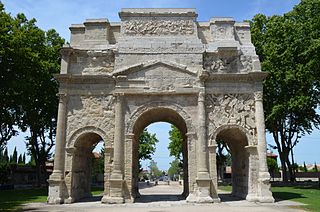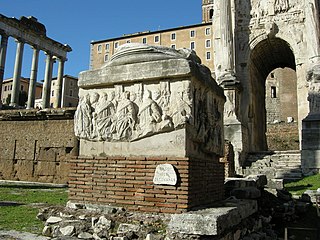Related Research Articles

Gaius Julius Caesar Augustus, also known as Octavian (Octavianus), was the founder of the Roman Empire; he reigned as the first Roman emperor from 27 BC until his death in AD 14. The reign of Augustus initiated an imperial cult as well as an era associated with imperial peace, the Pax Romana or Pax Augusta, in which the Roman world was largely free of armed conflict aside from expansionary wars and the Year of the Four Emperors. The Principate system of imperial rule established by Augustus lasted until the Crisis of the Third Century.

Lucius Septimius Severus Pertinax was a Roman politician who served as emperor from 193 to 211. He was born in Leptis Magna in the Roman province of Africa. His father was Carthaginian; his mother of Roman descent. As a young man he advanced through the customary succession of offices under the reigns of Marcus Aurelius and Commodus. Severus seized power after the death of the emperor Pertinax in 193 during the Year of the Five Emperors.

Aphrodisias was a small ancient Greek Hellenistic city in the historic Caria cultural region of western Anatolia, Turkey. It is located near the modern village of Geyre, about 100 km (62 mi) east/inland from the coast of the Aegean Sea, and 230 km (140 mi) southeast of İzmir.

The Praetorian Guard was an elite unit of the Imperial Roman army that served as personal bodyguards and intelligence agents for the Roman emperors.

The Roman emperor was the ruler and monarchical head of state of the Roman Empire, starting with the granting of the title augustus to Octavian in 27 BC. The term "emperor" is a modern convention, and did not exist as such during the Empire. Often when a given Roman is described as becoming emperor in English, it reflects his taking of the title augustus and later basileus. Another title often used was imperator, originally a military honorific, and caesar, originally a surname. Early emperors also used the title princeps alongside other Republican titles, notably consul and pontifex maximus.

Legio III Gallica was a legion of the Imperial Roman army. The cognomen Gallica suggests that its earliest recruits came from veterans of the Gallic legions of Gaius Julius Caesar, a supposition supported by its emblem, a bull, a symbol associated with Caesar. The legion was based for most of its existence at Raphanea, Roman Syria, and was still active in Egypt in the early 4th century.

A triumphal arch is a free-standing monumental structure in the shape of an archway with one or more arched passageways, often designed to span a road, and usually standing alone, unconnected to other buildings. In its simplest form, a triumphal arch consists of two massive piers connected by an arch, typically crowned with a flat entablature or attic on which a statue might be mounted or which bears commemorative inscriptions. The main structure is often decorated with carvings, sculpted reliefs, and dedications. More elaborate triumphal arches may have multiple archways, or in a tetrapylon, passages leading in four directions.

The Historia Augusta is a late Roman collection of biographies, written in Latin, of the Roman emperors, their junior colleagues, designated heirs and usurpers from 117 to 284. Supposedly modeled on the similar work of Suetonius, The Twelve Caesars, it presents itself as a compilation of works by six different authors, written during the reigns of Diocletian and Constantine I and addressed to those emperors or other important personages in Ancient Rome. The collection, as extant, comprises thirty biographies, most of which contain the life of a single emperor, but some include a group of two or more, grouped together merely because these emperors were either similar or contemporaneous.

Epigraphy is the study of inscriptions, or epigraphs, as writing; it is the science of identifying graphemes, clarifying their meanings, classifying their uses according to dates and cultural contexts, and drawing conclusions about the writing and the writers. Specifically excluded from epigraphy are the historical significance of an epigraph as a document and the artistic value of a literary composition. A person using the methods of epigraphy is called an epigrapher or epigraphist. For example, the Behistun inscription is an official document of the Achaemenid Empire engraved on native rock at a location in Iran. Epigraphists are responsible for reconstructing, translating, and dating the trilingual inscription and finding any relevant circumstances. It is the work of historians, however, to determine and interpret the events recorded by the inscription as document. Often, epigraphy and history are competences practised by the same person. Epigraphy is a primary tool of archaeology when dealing with literate cultures. The US Library of Congress classifies epigraphy as one of the auxiliary sciences of history. Epigraphy also helps identify a forgery: epigraphic evidence formed part of the discussion concerning the James Ossuary.

Nicopolis or Actia Nicopolis was the capital city of the Roman province of Epirus Vetus. It is located near Preveza, Greece. The city was founded in 29 BC by Octavian in commemoration of his victory in 31 BC over Antony and Cleopatra at the Battle of Actium nearby.

The Edict on Maximum Prices was issued in 301 AD by Diocletian. The document denounces monopolists and sets maximum prices and wages for all important articles and services.

The Arch of Septimius Severus at the northwestern end of the Roman Forum is a white marble triumphal arch dedicated in 203 AD to commemorate the Parthian victories of Emperor Septimius Severus and his two sons, Caracalla and Geta, in the two campaigns against the Parthians of 194-195 and 197–199. After the death of Septimius Severus, his sons Caracalla and Geta were initially joint emperors. Caracalla had Geta assassinated in 212; in the practice now known as damnatio memoriae, Geta's memorials were destroyed and all images or mentions of him were removed from public buildings and monuments. Accordingly, Geta's image and inscriptions referring to him were removed from the arch.

The Dominate, also known as the late Roman Empire, is the despotic form of imperial government of the late Roman Empire. It followed the earlier period known as the Principate. Until the empire was reunited in 313, this phase is more often called the Tetrarchy.

The Roman imperial cult identified emperors and some members of their families with the divinely sanctioned authority (auctoritas) of the Roman State. Its framework was based on Roman and Greek precedents, and was formulated during the early Principate of Augustus. It was rapidly established throughout the Empire and its provinces, with marked local variations in its reception and expression.
In Ancient Roman religious tradition, Actia was a festival of Apollo, celebrated at Nicopolis in Epirus, with wrestling, musical contests, horse racing, and sea battles. It was reestablished by Augustus, in commemoration of his victory over Mark Antony off Actium in 31 BC; that it was probably the revival of an ancient festival is suggested by the celebrated temple of Apollo at Actium, which is mentioned by Thucydides, and Strabo, and which was enlarged by Augustus. The games instituted by Augustus were celebrated every five years ; they received the title of a sacred agon and were also called Olympia.

The Constitution of the Roman Empire was an unwritten set of guidelines and principles passed down mainly through precedent. After the fall of the Roman Republic, the constitutional balance of power shifted from the Roman Senate to the Roman Emperor. Beginning with the first emperor, Augustus, the emperor and the Senate were theoretically two co-equal branches of government. In practice, however, the actual authority of the imperial Senate was negligible, as the emperor held the true power of the state. During the reign of the second emperor, Tiberius, many of the powers that had been held by the Roman assemblies were transferred to the Senate.

The Senate of the Roman Empire was a political institution in the ancient Roman Empire. After the fall of the Roman Republic, the constitutional balance of power shifted from the Roman Senate to the Roman Emperor. Beginning with the first emperor, Augustus, the Emperor and the Senate were technically two co-equal branches of government. In practice, however, the actual authority of the imperial Senate was negligible, as the Emperor held the true power of the state. As such, membership in the senate became sought after by individuals seeking prestige and social standing, rather than actual authority. During the reigns of the first Emperors, legislative, judicial, and electoral powers were all transferred from the "Roman assemblies" to the Senate. However, since the control that the Emperor held over the senate was absolute, the Senate acted as a vehicle through which the Emperor exercised his autocratic powers.

A senatus consultum is a text emanating from the senate in Ancient Rome. It is used in the modern phrase senatus consultum ultimum.

The Five-Columns monument is a dedicatory addition to the Rostra in the Roman Forum dating to the early fourth century CE. This monument was part of the Tetrarchy's expansion of the Forum and is connected to the tenth anniversary of the Caesares within the four-ruler system. It is also referred to as the Fünfsäulendenkmal as well as the four-column monument, depending on Jupiter's inclusion.
References
- 1 2 3 4 Kokkinia, Christina (2016). "The Design of the "Archive Wall". Tekmeria. 13: 12, 16, 22–42, 51. doi: 10.12681/tekmeria.8627 .
- ↑ Reynolds, Joyce M. (1982). Aphrodisias and Rome: documents from the excavation of the theatre at Aphrodisias. Journal of Roman studies monographs. London.
{{cite book}}: CS1 maint: location missing publisher (link) - ↑ Culham, Philip (1989). "Archives and Alternatives in Republican Rome". Classical Philology. 84 (2): 102. doi:10.1086/367146. S2CID 162304496.
- 1 2 Chaniotis, Angelos (2016). "Memory, Commemoration & Identity in an Ancient City: The Case of Aphrodisias". Daedalus. 145 (2): 94. doi:10.1162/DAED_a_00379. S2CID 57569822.